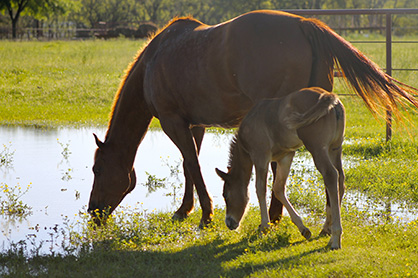You Can’t Always Follow Your Gut with an EMS Equine
by: Eleanor M. Kellon, VMD for Equine Cushing’s and Insulin Resistance Group Inc.
Following your gut instinct is good advice in some situations, but gut, and even good old common sense, can also be wrong. This is where fact and science come in.
Correctly caring for an equine with metabolic syndrome (EMS) takes some major lifestyle changes. It is up to the caretaker to implement those changes. This can be a major advantage for the horse, who doesn’t have to rely on his own will power, or it can throw any number of obstacles in his path.
We hear things like, “The horse can’t possibly be happy without pasture,” despite the fact that millions of equines around the world are; many do not even have pasture as an option. Another is that they can’t possibly be healthy on a diet restricted in amounts or types of food, when in truth, it is the human imposing their own emotional reaction to that possibility on the horse.
Most dangerous are objections that sound like they are based in science when they are not. One is that not permitting an EMS equine 24/7 access to food will cause stress and a cortisol increase, which will actually make him worse. This has a ring of truth to it, but it’s wrong. Here is just some of the research:
Sticker, et al., 1995, fed mares either 100% of requirements or restricted calories by 50%. The restricted mares had a drop in cortisol levels.
DePew, et al., 1994, fasted mares and stallions for 19 hours then fed a pellet and hay meal. Cortisol rose after feeding and did not change in response to fasting for 19 hours.
Glunk, et al., 2015, fed adult Quarter horses a restricted hay diet of 1% of their body weight either as loose hay or from slow feeder nets, divided into two feedings, with 15 hours between the afternoon and morning meals. The floor fed horses finished their meals much quicker. There was no difference in cortisol levels between the two types of feeding. Horses were sampled every 30 minutes after meals and hourly between feedings.
Cortisol dropped in both groups over the 28-day trial, despite the markedly restricted feeding and weight loss.
Storer, et al., fed both normal and hyperleptinemic (EMS/IR) mares either constant pasture, free-choice hay or hay and pellets only once daily. The mares fed only once daily had an expected exaggerated insulin and glucose peak after feeding, but their cortisol levels were lower than the mares with constant access to hay or pasture at all testing times.
Freestone, et al., 1991, did find small, but not statistically significant, rises in cortisol in ponies fasted 24 to 72 hours. This is consistent with the tendency of ponies, but not horses, to develop exaggerated release of fat into the bloodstream with fasting. The metabolism of ponies (and minis, donkeys) is distinctly different from horses.
What about the fact that feral horses spend 18 to 20 hours a day eating?
This observation does not automatically mean horses have to spend this much time eating to be metabolically healthy. You have to remember that grass is over 70% water, while hay is typically around 10% and a much more concentrated calorie source than pasture. They have to spend that much time eating native pasture to get enough calories.
By all means feed, your EMS horse with a slow feeding set up to avoid long gaps with no food that might lead to insulin peaks and also just to keep her busy, but don’t worry that going without food for even short periods, will increase cortisol and make EMS worse. Research has proven that’s simply not the case. In fact, in study after study a drop in cortisol has been found with fasting or restricted feeding of horses.
About ECIR Group Inc.
Started in 1999, the ECIR Group is the largest field-trial database for PPID and EMS in the world and provides the latest research, diagnosis, and treatment information, in addition to dietary recommendations for horses with these conditions. Even universities do not and cannot compile and follow long term as many in-depth case histories of PPID/EMS horses as the ECIR Group.
In 2013 the Equine Cushing’s and Insulin Resistance Group Inc., an Arizona nonprofit corporation, was approved as a 501(c)3 public charity. Tax deductible contributions and grants support ongoing research, education, and awareness of Equine Cushing’s Disease/PPID and EMS.
THE MISSION of the ECIR Group Inc. is to improve the welfare of equines with metabolic disorders via a unique interface between basic research and real-life clinical experience. Prevention of laminitis is the ultimate goal. The ECIR Group serves the scientific community, practicing clinicians, and owners by focusing on investigations most likely to quickly, immediately, and significantly benefit the welfare of the horse.











